New Zealand Fire Service
| Whakaratonga Iwi (Māori) | |
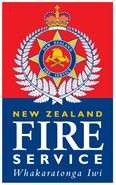 | |
| Leading integrated fire and emergency services for a safer New Zealand | |
| Operational area | |
|---|---|
| Country | New Zealand |
| Agency overview | |
| Established | 1 April 1976 |
| Dissolved | 30 June 2017 (replaced by Fire and Emergency New Zealand) |
| Annual calls | 74,879 (2015–16)[1] |
| Employees |
1,700 career firefighters[1] 8,300 urban volunteer firefighters[1] |
| Staffing |
585 management and support 76 communications centre |
| Fire chief | Paul McGill (National Commander) |
| Facilities and equipment | |
| Stations |
79 career[1] 360 volunteer[1] |
| Website | |
|
fire | |
The New Zealand Fire Service (NZFS, Māori: Whakaratonga Iwi, "Service to the People"[2]) was New Zealand's main firefighting body from 1 April 1976 until 1 July 2017 - at which point it was dissolved and incorporated into the new Fire and Emergency New Zealand.
Legal Authority
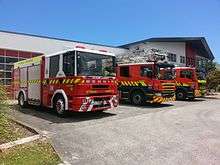
The NZFS was somewhat unusual, internationally, in that it had jurisdiction over the entire country with no division by region or city. It was the result of the New Zealand Fire Service Act (1975) which nationalised the various District-level brigades which had developed across the country.
Responsibility
The New Zealand Fire Service was predominantly configured as an Urban Fire & Rescue Service. The Fire Service Act placed responsibility on the NZFS for firefighting in gazetted Urban Fire Districts, totalling about 3% of New Zealand's land area but covering 85% of the country's population. The remainder of the land was covered by Rural Fire Authorities (RFAs) that acted under the Forest and Rural Fires Act. Fire Service brigades responded outside their Districts to deal with structure and rescue incidents, and usually undertook the initial suppression attack on wildland fires.
Note: The New Zealand Department of Conservation was a RFA with responsibility for firefighting within recognised State areas, including National Parks, totalling about 30% of the country. The New Zealand Defence Force remains responsible for all Defence Areas as defined through the Defence Act. With these two agencies included, the NZFS and territorial local authority RFAs formed the bulk of the firefighting capability in New Zealand. There continues some contribution from Industry Fire Brigades (those run by commercial entities, for example forestry companies or Airport Authorities).
Organisation
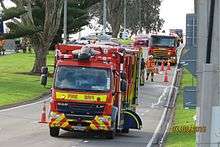
Central Government
The entire organisation reported to the Minister of Internal Affairs, by way of the New Zealand Fire Service Commission. The Commission was composed of five members, and the Minister was required by law to appoint at least one person who was either a fire engineer or had experience as a senior operational fire fighter. The New Zealand Fire Service Commission was also the National Rural Fire Authority.
Chief Executive / National Commander
Beneath the Commission were the positions of Chief Executive and National Commander. At the time of dissolution both positions were filled by Paul McGill. Where the Chief Executive did not have operational fire fighting experience, a separate National Commander was appointed to be the most senior operational fire fighter in the country. The National Commander may have taken control at a particularly serious incident, though this happened very rarely.
The Chief Executive had a number of direct reports, though these were concerned with matters such as human resources and finance rather than operational matters.
Chain of Command
The country is broken into five fire regions: Region 1 (Northland/Auckland), Region 2 (Waikato/Bay of Plenty/Gisborne), Region 3 (Lower North Island), Region 4 (South Island north of the Waitaki River), and Region 5 (South Island south of the Waitaki River). Each region is in the charge of a Fire Region Commander. All FRCs report directly to the National Commander, and are promoted from the ranks of operational staff. An FRC may take control of a major incident, and is ultimately responsible for any incident at which they are present even if they are not the Officer-in-Charge.
Reporting to the Fire Region Commander are the Area Commanders and Assistant Area Commanders who manage the 24 areas contained within the regions. The areas are:
- Region 1: Muri-Whenua, Whangarei-Kaipara, Waitemata, Auckland City, Counties-Manukau
- Region 2: Waikato, East Waikato, Bay of Plenty Coast, Central Lakes, Tairawhiti
- Region 3: Hawke's Bay, Taranaki, Wanganui, Manawatu, Hutt-Wairarapa, Wellington
- Region 4: Tasman-Marlborough, West Coast, Canterbury, Christchurch City, South Canterbury
- Region 5: Central-North Otago, East Otago, Southland
Assistant Area Commanders are primarily responsible for managing the career districts, while the Area Commanders have overall responsibility for the area as well as for the volunteer Chief Fire Officers of each volunteer fire districts within their areas. These are the officers who are ultimately entrusted – via the Fire Service Act – with the powers that are exercised at the scene of an incident to 'deal with' the emergency. These powers are far-reaching – they provide authority to commandeer, demolish or destroy whatever is required in the course of their duties, given no more suitable options.
Each Chief Fire Officer (CFO) will have a Deputy Chief Fire Officer (DCFO) and a number of Senior Station Officers (SSOs) and Station Officers (SOs) reporting to them. The minimum number of firefighters required to man an appliance is four – an officer-in-charge, a driver/pump operator, and two firefighters – although most appliances are equipped to carry an extra two firefighters.
- Station Officer (SO) – In charge of the crew and the officer with the delegated authority of the CFO at any response.
- Senior Firefighter (SFF) – an SFF is an experienced Firefighter who is in a position to provide leadership in the absence of a Station Officer. Suitably qualified SFFs may stand in for an SO on a temporary basis.
- Qualified Firefighter (QFF)
- Firefighter (FF) – the baseline rank within the Fire Service.
An SSO may run in place of an SO as required or at their own discretion. In career districts the SSOs are strategically located to provide a more experienced command officer who is usually placed such that they are responded to most incidents of significance.
Staffing
Career staff
The New Zealand Fire Service employed 1,713 professional career firefighters, 444 support staff and 80 communication centre staff.
Each career fire station has a number of watches (shifts). Full-time career stations have four watches, red, brown, blue and green, rotating on a "four-on four-off" schedule: two 10-hour day shifts, followed by two 14-hour night shifts, followed by four days off. Combination career and volunteer stations may have a yellow watch, in which career staff work four 10-hour day shifts per calendar week, having one weekday, Saturday and Sunday off. Non-operational staff are "black watch", and work a regular 40-hour week.[3]
Career Firefighters respond to 70–80% of the incidents the NZFS attends and protect 80% of the population.
Career firefighters numbers are relatively stable with low turnover. The Fire Service usually recruits twice-yearly, and can receive up to 700 applications for just 48 positions on each intake, making competition high and job prospects poor compared to other industries.[4] Initial training for career firefighters is done on an intensive 12-week residential course at the national training centre in Rotorua that covers not only traditional firefighting subjects but others required of a modern professional Fire and Rescue Service. Topics such as; urban search and rescue (USAR), motor vehicle extrication and hazardous materials.
Career firefighters provide the NZFS personnel that staff the nations specialised USAR Response teams. Additional specialised training is provided for these personnel, however all paid career firefighters are trained to a baseline USAR 'Responder' level.
Volunteers
Career firefighters make up only 20 percent of the New Zealand Fire Service's firefighting manpower; the remaining 80 percent of firefighters are volunteers, who receive no payment for their time or labour. The 8,300 volunteer firefighters belong to the 360 volunteer fire brigades,[1] mainly serving small towns, communities and outer suburbs which career stations do not cover, and respond to 20–30% of all incidents the New Zealand Fire Service attends.
Volunteer firefighters have diverse backgrounds; around 14 percent are women, compared to just 2.8 percent in the career ranks.[1] Volunteers are on-call; when an emergency call comes through, firefighters are alerted through pagers and a siren atop the fire station.
The minimum age to become a volunteer firefighter in the New Zealand Fire Service is 16, although those under 18 require parental consent.[5][6] Initial training is done within the local volunteer fire brigade at their weekly training nights and culminates in a seven-day residential recruit course, normally held at the National Training Centre (NTC) in Rotorua or the Woolston Training Centre in Christchurch. Training includes hose drills, ladder drills, portable pumps, and breathing apparatus use (BA), which is carried out in BATB (Breathing Apparatus Training Building) and RFTB (Realistic Fire Training Building) simulators. The BATB is a gas-fired training facility and the RFTB is a live fire scenario.
Volunteer units within the NZFS organisation also provide support services over and above the role of the Firefighter. Various Operational Support Units (OSUs) manned by volunteers are attached to Fire Districts and Brigades across New Zealand, which provide non-firefighting assistance at large-scale incidents. These include traffic and crowd control, scene cordons and lighting, basic first aid, salvage, communications and logistics, and even catering.[7] The biggest of them, Auckland Operational Support Unit, also known as the Auckland Volunteer Fire Brigade, was founded in 1933 and provides a true voluntary community service. Its members get no payment for expenses incurred and time spent at emergencies. The Unit is the biggest volunteer fire brigade or unit in New Zealand with a membership of 60 and in the 2015 calendar year, members responded to more than 700 incidents.[8]
Insignia

A new colour scheme for helmets was introduced in August 2013, and rolled out in late 2013. Previously, yellow helmets were issued to Firefighters and Station Officers, white helmets to Chief Fire Officers, Area Commanders and Assistant National Commanders, with markings being the only discerning features. The changes saw Station Officer helmets change to red (trainee firefighter helmets, which were red, changed to green), and Area Commander and Assistant National Commander helmets change to silver. The change was to make it easier to identify the command structure at a large-scale, multi-agency incident.[9]
The epaulette markings used by the New Zealand Fire Service are identical to those used by the New Zealand Police and the New Zealand Army, except for the use of impellers instead of pips.
| Rank | Epaulette[10] | Helmet[10] |
|---|---|---|
| National Commander (NC) | silver crossed sword and baton below a crown | black |
| Deputy National Commander (DNC) | silver crossed sword and baton below an impeller | black |
| Assistant National Commander (ANC) | three impellers in a triangle below a crown | silver with two blue stripes |
| Area Commander (AC) | one impeller below a crown | silver with one blue stripe |
| Assistant Area Commander (AAC) | three impellers | silver |
| Chief Fire Officer (CFO) | impeller between two ferns below two impellers | white with two blue stripes |
| Deputy Chief Fire Officer (DCFO) | impeller between two ferns below one impeller | white with one blue stripe |
| Senior Station Officer (SSO) | two impellers | red with two blue stripes |
| Station Officer (SO) | one impeller | red with one blue stripe |
| Senior Firefighter (SFF) | two bars | yellow with two red stripes |
| Qualified Firefighter (QFF) | one bar | yellow with one red stripe |
| Firefighter (FF) | plain | yellow |
| Recruit Firefighter (RFF) | plain | fluro-green |
Role

The New Zealand Fire Service is first and foremost a firefighting service, as made obvious by the name. However, it is also increasingly called upon for other emergencies where firefighting skills and tools are helpful, including hazardous material incidents, motor vehicle accidents, natural disasters, and medical emergencies.
In the year to 30 June 2013, the Fire Service attended 70,900 callouts. Of those, 7.7 percent were for structural fires, 23.3 percent were for non-structural fires, 32.8 percent for non-fire emergencies, and 36.2 percent were false alarms. In the same period, 38 people died in 34 fatal fires.[11]
Examples of non-fire emergencies the Fire Service attend include:
- Road Crash Rescue – Extrication of entrapped persons in the aftermath of a motor vehicle accident
- High Angle Rescue – Rescue from the side of buildings; dangerous terrain (cliff faces, etc.)
- Hazardous Materials (HAZMAT) – The containment of a hazardous substance and decontamination of an environment or persons affected by a hazardous substance
- Natural Disasters – Addressing the problems caused by heavy rain and high winds (lifted roofing, power lines and trees down onto properties or across roadways, flooding)
- Urban Search and Rescue (USAR) – The New Zealand Fire Service is the lead agency for New Zealand USAR operations (Civil defence & emergency management Act 2002) They also manage three USAR Task Force level teams, providing communications and resources. Being the lead agency, the New Zealand Fire Service also coordinates the 17 NZ Response Teams which also provide light USAR support. Paid career NZFS firefighters have a baseline level of training in USAR techniques and make up the vast majority of the actual USAR team members.
- Medical Co-Response – Co-responding with ambulance services to "Code Purple" emergencies (e.g. cardiac and respiratory arrest)
- Medical First Response – Responding to medical emergencies in smaller communities where there is no local ambulance service, as well as in the main centres when an ambulance is unavailable or will be significantly delayed in attending an incident.
These additional areas have led the NZFS to begin the process of rebranding; it is now actively promoted as being the New Zealand Fire and Rescue Service as this is seen as a more accurate representation of their role in the community. At a government level the much-expanded role of the New Zealand Fire Service has been recognised, and as such the Fire Service Act 1975 (the legislation under which the service operates) is currently under review, with a view to replacing the Act with newer legislation which better supports their work.[12]
Appliances and vehicles
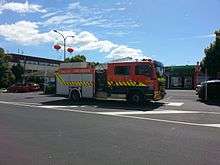
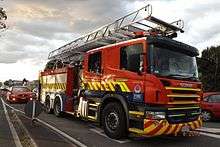

The New Zealand Fire Service operates around 850 fire appliances, including conventional pumping appliances and specialist appliances, and 330 support vehicles. Fire appliances are given a three- or four-digit number for identification; the first two digits specify the appliance's resident station (numbers may be repeated between areas), while the last one or two digits specify its function. An example is "Newlands 291" – 29 indicates the appliance is resident at Newlands fire station in Wellington, and 1 indicates its function is a pump.
Pumping appliances
The basic appliance in New Zealand is the Pump Tender, which is primarily equipped for fires. Typical equipment includes a pump (normally driven off the appliance engine via a power take-off); a high pressure hose reel for small fires and initial attack; a supply of high-pressure and low-pressure hoses for larger fires; fire-fighting foam; a standpipe and bar for accessing fire hydrants, and suction hoses for accessing non-reticulated water supplies; forcible entry tools such as Halligan bars, axes and sledgehammers; aluminium and wooden ladders; and a first aid kit with an automated external defibrillator.
The two major variations on the Pump Tender are the Pump Aerial Tender and the Pump Rescue Tender. The Pump Aerial Tender has an additional aerial ladder and monitor for high-rise and aerial attacks. The Pump Rescue Tender, in addition to firefighting equipment, carries extra equipment primarily for motor vehicle accidents and vehicle extrication. Typical equipment includes hydraulic rescue tools (aka "The Jaws of Life"), vehicle stabilisation equipment, and winches.
Most new pumping appliances for the New Zealand Fire Service are manufactured by the Fraser Engineering Group in Lower Hutt, and based on Iveco, Scania and most recently MAN chassis.[13] Other maunufacturers and chassis including Hino, Dennis, Mitsubishi/Fuso, International, Dodge, Bedford and Mack have been used in the past.
There are four sizes of pumping appliances, named Type 1 through Type 5:
- The Type 1 "Light" appliance is used in both urban and rural areas. It has a rear-mounted 1900 L/min pump with one low-pressure hose reel, a 2000 L onboard water tank, and around 5.2 m2 of locker space. New appliances are typically built on Iveco Eurocargo chassis.[14]
- The Type 2 "Medium" appliance is used in both urban and rural areas. It has the same features as the Type 1, but has an additional high-pressure hose reel and around 1.3 m2 extra locker space. New appliances are typically built on Iveco Eurocargo chassis.[15]
- The Type 3 "Heavy" appliance is used in urban areas. It has a mid-mounted 3800 L/min pump with two high-pressure hose reels, and a 1400 L onboard water tank. Since 2015, new appliances have typicallybeen built on MAN TGM chassis; prior to this they were typically built on Scania P-series chassis.[16]
- The Type 4 "Heavy Aerial" or "Bronto" appliance is used in urban areas. It has the same features as the Type 3, but is also fitted with a 17-metre aerial ladder and monitor. New appliances are typically built on Scania P-series chassis.[17]
- The Type 5 & 6 "Heavy Aerial" or "Bronto" appliance is used in urban/city areas. It has the same features as the Type 4, but is fitted with a 32-metre aerial ladder and montior, instead of a 17-metre. Some of the 32-metre appliances do not consist of any pumps, whereas some Type 5/6's do.
Pump Tender identification numbers ends in 1, 2 or 3 (e.g. Onehunga 221, Manurewa 301, Hastings 561); Pump Aerial Tender identification numbers end in 4, 5 or 6 (e.g. Ellerslie 274, Auckland 205, Parnell 256); and Pump Rescue Tender (PRT) identification numbers end in 7 (e.g. Auckland 207, Papatoetoe 347, Christchurch 217)
Specialist appliances
Career staff appliances may also carry more specialised items used for industrial rescue, light USAR and high-angle line rescue. In some areas, these are carried on separate Rescue Tenders or Emergency Tenders which do not have pumping capabilities.
Additional specialist appliances are usually strategically located in each fire district. Typyical appliances, their functions and identification numbers are as followed:
- Hydraulic elevating platforms with aerial monitor ("Snorkel") – non-pumping, typically 32 metres (105 ft) long (5)
- Turntable ladders – non-pumping, typically 32 metres (105 ft) long. (6)
- Technical (Heavy) Rescue Tender – Auckland Fire District only (8)
- Water tankers, to assist in water supply at properties or in areas without a reticulated supply (11)
- Hoselayers (12)
- Breathing Apparatus Tenders, to supply extra breathing apparatus cylinders and mobile cylinder refilling at major incidents (15)
- Command vehicles, to act as a mobile communications centre and incident control point at major incidents (14 or 18)
- Hazardous Materials Response (Hazmat) (16 or 18)
- Operational Support Vehicles (26, 28, 29)
- Lighting & Power Generation Units
- Fire Medical Vehicle (FMV) – prototype combination pump tender and medical first response vehicle.[18]
Communications
The NZFS works closely with the NZ Police in many respects – a key one of those is that the three Communications Centres which co-ordinate the Fire Service response across NZ are colocated with their Police Equivalents in Auckland, Wellington and Christchurch. The radio network used by the Fire Service for its nationwide coverage is provided and supported by the Police, although most urban areas provide for an exclusive Fire-only radio channel or channels.
In rural areas, the channel may be shared between both services. Generally this is an acceptable arrangement, though when either the Police or the Fire Service are particularly busy in an area with shared radio services, this can cause the other service some grief. In contrast, the fact that Police have ready and direct access to the Fire Communications Centre is occasionally of some value in terms of inter-agency liaison.
At the scene of an incident, VHF and UHF simplex frequencies are generally used. These are usually common between NZFS, NRFA, DoC and NZDF firefighters and discrete from the Police. Access to shared liaison channels is also provided, allowing for Ambulance, Police, Fire and other resources (for example aircraft that may be called upon to assist in firefighting) to co-ordinate.
CIMS
The New Zealand Fire Service was one of the key developers of the Coordinated Incident Management System which is now in widespread use throughout the NZ Emergency Services environment. This provides for a common set of terminology and procedures which lends itself to multi-agency incidents.
Notable incidents
- Southdown Freezing Works fire, 2008 – on 20 December 2008, Auckland firefighters were called out to a reported building fire in the suburb of Southdown. Upon crews arriving, a call was made to transmit a sixth-alarm response. Almost every crew from all over Auckland responded with at least two appliances coming from Rotorua and Hamilton. There was suspected asbestos inside some of the buildings that were alight, causing it to feed the fire.[19][20]
- Tamahere coolstore fire, 2008 – on 5 April 2008, Hamilton firefighters were called out to a fire alarm activation at the Icepak Coolstores southeast of the city at Tamahere. While investigating the cause of the alarm the propane-based refrigerant ignited explosively, injuring all eight firefighters and destroying one fire engine. One firefighter later died in hospital of his injuries. The fire was upgraded to a fifth-alarm response, with appliances coming from as far afield as Onehunga and Taupo. A water tender from nearby Hamilton Airport and Fonterra milk tankers were also called in to assist with water supply.[21] Icepak Coolstores and the refrigeration company contracted to maintain the coolstores pleaded guilty to health and safety breaches, and combined were ordered to pay $393,000 in fines and reparation.[22]
- ICI Riverview fire, 1984 – on 21 December 1984, a fire broke out at the ICI Riverview chemical warehouse in Mount Wellington, Auckland, killing one person. Thirty-one firefighters suffered ill effects from the toxic fumes given out in the fire.
Pre-Fire Service
- Ballantyne's fire, 1947 – on 18 November 1947, a fire broke out at the Ballantyne's department store in central Christchurch, killing 41 people. It remains the deadliest fire in New Zealand.
- Seacliff Lunatic Asylum fire, 1942 – on the evening of 8 December 1942, a fire broke out in Ward 5 at the Seacliff Lunatic Asylum, north of Dunedin, killing 28 of the 39 female patients housed within. A shortage of nursing staff due to World War II, as well as the lack of sprinklers in the ward, contributed to the deaths.
See also
References
- 1 2 3 4 5 6 7 "Annual Report for the year ended 30 June 2014" (PDF). New Zealand Fire Service Commission. Archived from the original (PDF) on 3 January 2015. Retrieved 3 January 2015.
- ↑ "Fireman stood down in Maori words row". The Dominion Post (via Stuff.co.nz). 6 November 2007. Retrieved 27 March 2014.
...the Maori words "whakaratonga iwi" – meaning "service to people"...
- ↑ "Shifts and Rosters". New Zealand Fire Service. Retrieved 19 January 2015.
- ↑ "Job opportunities – Firefighter". Careers New Zealand. Retrieved 24 January 2015.
- ↑ "An Introduction to Volunteering". New Zealand Fire Service. Retrieved 18 February 2014.
- ↑ Bryant, Grant (20 June 2008). "Mataura fire chief calls for volunteer firefighters". Otago Daily Times. Retrieved 18 February 2014.
- ↑ "About Operational Support". Hutt-Wairarapa Operational Support Unit. Retrieved 3 April 2014.
- ↑ "Auckland OSU, Introduction". Auckland OSU. 17 September 2016.
- ↑ "Heads Up" (PDF). Fire + Rescue. New Zealand Fire Service (94): 7. August 2013. ISSN 1176-6670. Archived from the original (PDF) on 5 May 2017. Retrieved 27 March 2013.
- 1 2 "Rank insignia". New Zealand Fire Service. Retrieved 12 December 2015.
- ↑ "Emergency Incident Statistics 2012–13" (PDF). New Zealand Fire Service. Retrieved 10 January 2015.
- ↑ "New Zealand Department of Internal Affairs, Review of Fire Legislation". Archived from the original on 6 April 2007.
- ↑ Edwards, Simon (1 July 2014). "Hot stuff: Firm marks milestone". Hutt News. Lower Hutt. p. 5.
- ↑ "Type 1 fire appliance brochure". Fraser Engineering. Retrieved 18 September 2016.
- ↑ "Type 2 fire appliance brochure". Fraser Engineering. Retrieved 18 September 2016.
- ↑ "Type 3 fire appliance brochure". Fraser Engineering. Retrieved 18 September 2016.
- ↑ "Type 4 fire appliance brochure". Fraser Engineering. Retrieved 18 September 2016.
- ↑ "Multi-purpose fire, medical vehicle on trial". Television New Zealand. 20 June 2014. Retrieved 12 January 2015.
- ↑ "Southdown Freezing Works, 20 December 2008".
- ↑ "Southdown Freezing Works 20 Dec 2008".
- ↑ "Inquiry into the Explosion and Fire at Icepak Coolstores, Tamahere, on 5 April 2008" (PDF). New Zealand Fire Service. September 2008. Retrieved 6 March 2017.
- ↑ "Companies, director sentenced over fatal coolstore fire". Stuff.co.nz. 15 December 2009. Retrieved 6 March 2017.
External links
| Wikimedia Commons has media related to Firefighting in New Zealand. |
- Official website
- Fire Service Act 1975 No 42 – enabling legislation of the Fire Service
- ICAD incident report summary – lists incidents attended by the NZFS in the past seven days.
- 111 Emergency (View New Zealand Fire Vehicles)